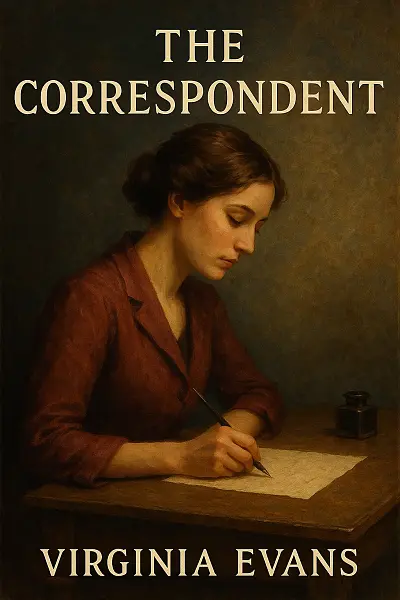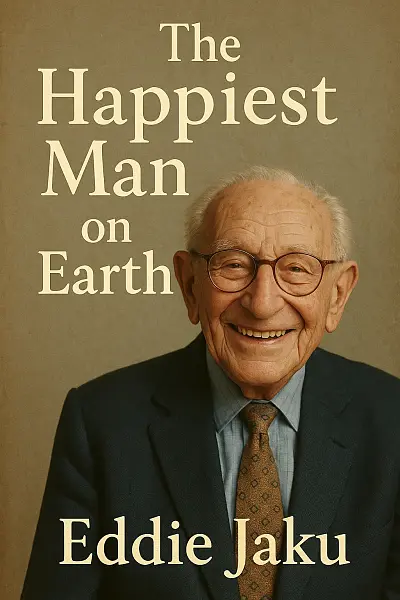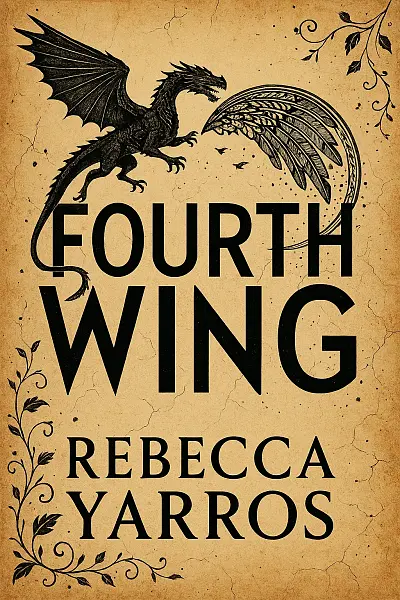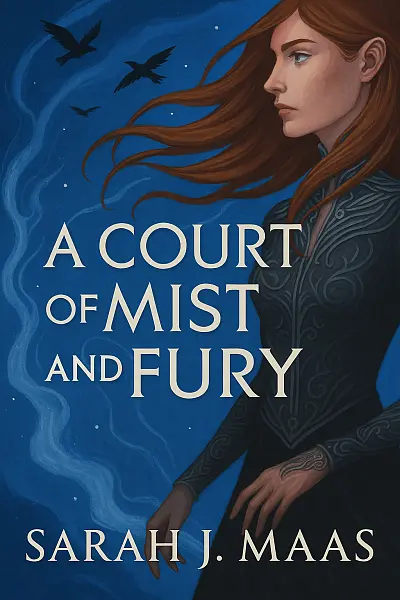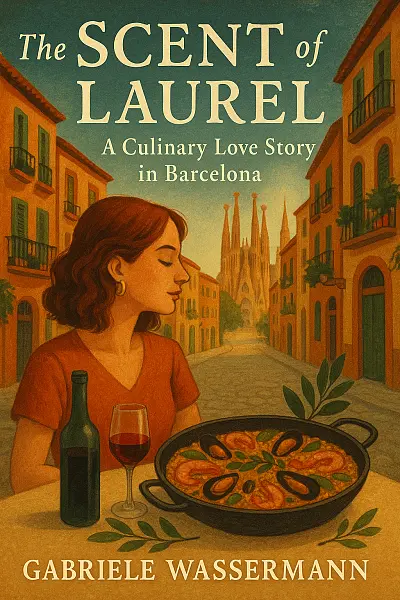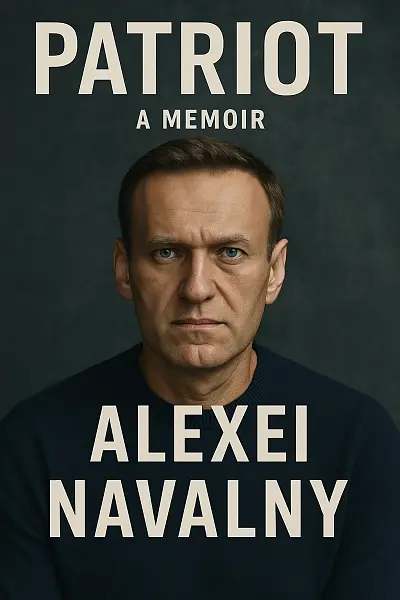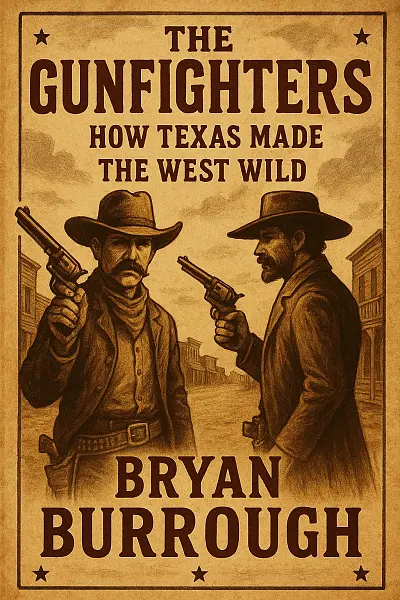
The Gunfighters: How Texas Made the West Wild
by: Bryan Burrough
Texas stands at the heart of myth and reality as restless gunfighters, outlaws, and lawmen carve out a place in the Wild West. As the frontier explodes with violence, dueling culture shifts, and booming cattle trails fuel chaos, ambitious figures like Jesse James and Billy the Kid battle for survival and fame. When sensationalist newsmen catch on, the line between legend and truth blurs further, raising the stakes for everyone caught in the storm.
With a lively, myth-busting style, Burrough pulls you in, making you wonder: will the truth of these gunfighters ever outshine their legend?
""In the myth of the wild West, it was not just the guns that forged history, but the stories Texans told with every shot fired and every line drawn.""
Literary Analysis
Writing Style
Atmosphere
- Dusty, kinetic, and cinematic—Burrough plunges you straight into the heat and grit of Texas’s violent frontier. The mood is restless, charged with tension and bravado, but there’s a constant hum of historical curiosity that keeps things from turning too grim or pulpy.
- Expect tavern smoke, anxious silences before gunshots, and the wild edges of towns trembling at the possibility of chaos. The atmosphere crackles with a blend of nostalgia and skeptical inquiry, never letting you forget the real stakes and shadows behind the legend.
Prose Style
- Direct, vivid, and sneakily witty. Burrough’s sentences bite when they need to, laying down events with journalistic clarity and pacing, but he also let’s loose with sly asides and expressive turns of phrase. There’s a clear fondness for character detail and scene-setting—think of it as history with a showman’s flair, but never losing sight of factual backbone.
- There’s no purple prose or drawn-out metaphors here; it’s accessible, brisk, and slyly insightful, aimed at keeping you turning pages rather than wading through literary flourishes.
Pacing
- Lively and well-timed, almost episodic. Burrough keeps chapters tight and action moving, never lingering too long over one shootout or personality before barreling into the next skein of violence or intrigue.
- Pauses for context or analysis are well-placed, breaking up the bursts of gunfire with just enough historical explanation so readers never feel lost—but don’t expect lengthy digressions or dry academic tangents. The narrative gallops more than it strolls.
Dialogue & Characterization
- Dialogue snaps with authenticity, often reconstructed from historical records but delivered with dramatic flair. Voices are distinct, personalities pop, and you feel like you’re eavesdropping in aging saloons or tense jail cells.
- Even minor players get textured sketches—nobody fades into generic “cowboy” territory. Burrough enjoys poking at myths, giving real substance to figures who usually live in caricature.
Overall Rhythm & Feel
- Smooth, gripping, and a little wild, just like the West it describes. It’s fast-paced enough to thrill but conscious enough to dig beneath the surface, rewarding both casual readers looking for a ride and history buffs craving substance.
- If you like your nonfiction immersive, thoughtful but never slow, and delivered with a wink to classic Western lore, Burrough’s style delivers in spades.
Key Takeaways
- Outlaw duels on dusty Texas streets that redefine Wild West chaos
- Sam Bass’s legendary train heist—adrenaline, double-crosses, and gun smoke
- Bryan Burrough’s punchy prose cuts straight to the heart of Texas mythmaking
- Lawmen and desperados trade bullets & banter—every showdown sizzles with tension
- Unexpected tales of fearless women riding shotgun in a men’s world
- Epic barroom brawls where alliances shift with a single glance
- A candid look at the blurred line between hero and villain—nobody gets off clean
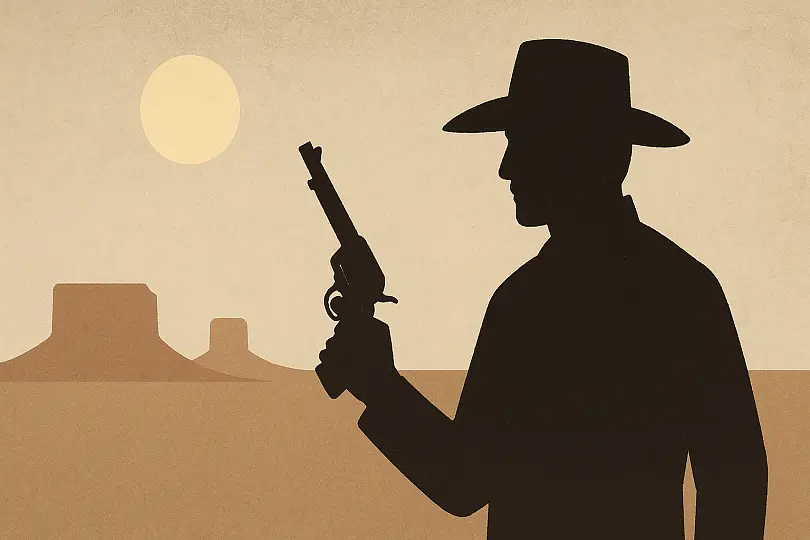
Texas grit meets outlaw legend—where real history outguns the myth.
Reader Insights
Who Should Read This
Alright, here’s who I’d totally recommend The Gunfighters: How Texas Made the West Wild to—and who might want to skip it:
If you geek out over the Old West, cowboy legends, or just love a wild, cinematic slice of American history, you’ll have a blast with this one.
- History buffs, especially anyone obsessed with tales of lawmen, outlaws, and dusty Texas towns, will probably tear through these pages.
- If true crime is your jam (but make it 19th-century style), there’s a lot here to satisfy—Burrough goes deep on the real people behind the myths.
- Fans of biographies and character-driven nonfiction should appreciate how the big personalities come off the page.
- If you liked Empire of the Summer Moon or documentaries like The American West, this one feels like it’s right up your alley.
- Anyone who loves books that demystify legends and get into the messy, sometimes uncomfortable truth will find so much to dig into.
On the flip side, this probably isn’t the book for you if…
- You’re not into American history or couldn't care less about the wild west—honestly, the subject matter is front and center.
- If you want a quick, light read or something escapist, this one’s fairly detail-packed, with lots of names, dates, and context.
- Folks looking for fast-paced fiction or classic “shootout” narratives might find the focus on historical accuracy a little slower than they’d like.
- If you’re just not into nonfiction or you prefer stories with neat, happy endings—these real-life tales are much grittier and a bit morally messy.
Bottom line: If the drama and chaos of the Texas frontier sounds even a bit intriguing, you’ll be hooked. But if history isn’t your thing, you might want to pass or look for something a little lighter.
Story Overview
Ready to get swept into the wild heart of Texas?
The Gunfighters: How Texas Made the West Wild by Bryan Burrough is a captivating journey through the untamed landscapes and larger-than-life personalities that defined the legendary Old West. From notorious outlaws and relentless lawmen to epic showdowns and bullet-riddled towns, this book dives deep into the true stories and sprawling myths that forged the Lone Star State’s reputation.
At its core, this isn’t just about shootouts and cowboy bravado — it’s about the gritty struggle for control in a land where justice and chaos were constantly at war. If you’re craving epic tales, complex characters, and high-stakes drama all set against the windswept plains and sunbaked streets of Texas, you’ll find everything you’re after in these pages.
Main Characters
-
Wild Bill Hickok: Legendary lawman and gunslinger whose reputation for lightning-fast draws defines much of the mythos around Texas gunfighters. His confrontations and tragic end help anchor the book’s exploration of fame and violence.
-
John Wesley Hardin: Infamous Texan outlaw known for his ruthlessness, unpredictable temper, and record for deadly shootouts. His lengthy criminal journey illustrates the blurred lines between heroism and villainy in the West.
-
Ben Thompson: Charismatic gambler and gunman, Thompson’s volatile loyalty and quick temper make him both dangerous and magnetic. His complex relationships and ultimate downfall highlight the precarious nature of frontier lawmen.
-
Dallas Stoudenmire: Fearless (and often reckless) marshal with a penchant for showy violence, Stoudenmire’s efforts to tame lawless towns underline the book’s examination of the challenges facing early law enforcement.
-
Bill Longley: Notorious for his brutal killings and later attempts at redemption, Longley’s arc underscores the dark psychological currents at play among Texas’s most famous gunfighters.
If You Loved This Book
If you got swept away by Empire of the Summer Moon by S.C. Gwynne, you’ll instantly recognize the same addictive blend of vivid storytelling and sharp historical analysis in The Gunfighters: How Texas Made the West Wild. Both books zero in on Texas as a crucible for larger American myths, and Burrough delivers the same kind of gripping narrative energy—balancing hard facts with epic legends—that made Gwynne’s work so compelling. Fans of Larry McMurtry’s classic Lonesome Dove will also feel right at home here; Burrough channels that wild, unpolished spirit and gives real-life gunfighters the larger-than-life treatment usually reserved for fiction, but without losing sight of their flaws and contradictions. There’s a similar mixture of grit, humor, and melancholy, pulling you into the unpredictable heart of the West.
For anyone glued to the screen during Deadwood’s run on HBO, The Gunfighters will certainly strike a chord. The book echoes Deadwood in its unflinching depiction of frontier lawlessness, moral ambiguity, and the way civilization was both imposed and resisted at gunpoint. The chaos, the colorful rogues, and the feeling that every man was making up the rules as he went along—Burrough captures that raw, unscripted energy and makes history pulse with immediacy. Whether you prefer pages or pixels, this book stands right at the intersection of fact and legend, inviting you to linger where the Old West gets most interesting.
Expert Review
Is the legend of the “Wild West gunfighter” little more than a smoky fever dream spun by pulp fictions and Hollywood, or does a bloody, distinctly Texan reality flicker beneath the myth? Bryan Burrough’s The Gunfighters: How Texas Made the West Wild rides straight into this question, daring readers to reconsider what they think they know—not just about Jesse James and Billy the Kid, but about how American violence and mythmaking are entwined at the bone. It’s a bold, sometimes raucous intellectual shootout over memory, history, and the messy birth of modern America.
What makes Burrough’s writing absolutely sing is his swaggering yet precise narrative voice. He marshals journalistic exactitude—think sharply drawn scenes, vivid period details, no-nonsense pacing—with the momentum of a top-tier thriller. Chapters whip from cattle trails to lawless border towns, never lingering too long but always drawing out the texture of the times: dusty, dangerous, and feverishly alive. There’s a stylish panache to the way he blurs scholarly synthesis, storytelling, and sly cultural critique. Through alternating close-ups of infamous gunslingers and sweeping landscape shots of Texas in upheaval, Burrough balances microhistory and big-picture analysis. His language pivots smoothly between muscle and nuance—tight, evocative, but not self-indulgent. Even when addressing well-trodden figures, he avoids cliché, reframing stock legends as products of their era’s violence-as-virtue and the exploding appetite for sensationalist news.
At its core, The Gunfighters is haunted by the idea that myth sometimes reveals deeper truths than bald fact allows—and yet those myths come at real cost. Burrough’s strongest theme is the paradoxical American romance with violence: the roots of the “honor culture,” nurtured in dueling codes and fertilized by the trauma of war, that spilled from Texas into the rest of the West. He’s razor-sharp in showing how media—first newspapers, then novels, eventually film—turned actual bodies and crimes into a fertile legendarium. This isn’t just a history lesson; it’s a diagnosis of how contemporary America still marinates in legends of rugged masculinity and righteous violence. The wildness, Burrough argues, was never just lawlessness—it was the engine of a national identity struggling with race, power, and control. At a time when the culture still grapples with myth versus reality (and with the trauma behind those myths), this book lands as both indictment and love letter to the American story.
For readers of Forget the Alamo or Cormac McCarthy’s Blood Meridian, Burrough’s take is less archly literary but more accessible, with a journalistic briskness that still honors complexity. He carves out a middle ground between revisionist Westerns and hagiographic nostalgia, making the case for Texas as crucible—not just for notorious outlaws, but for the very idea of the American outlaw hero.
The Gunfighters dazzles with its energy and insight, though in compressing so many figures and threads, a few emotional nuances and minor voices sometimes fall to the wayside. Still, its propulsive style and thematic clarity make it essential reading for anyone curious about how legend and history fuel one another—and why that tension still matters. For fans of American history, myth, and the West, this is a ride well worth taking.
Community Reviews
I almost bailed when Burrough described that midnight standoff in the dusty street, but then the tension yanked me back in. The way he painted fear on every gunslinger’s face felt too real to walk away from.
Burrough’s wild ride woke me up at 3am thinking about John Wesley Hardin’s stare, sharp as rattlesnake fangs. Couldn’t shake the feeling he was lurking just outside my window. These gunfighters are nightmares on horseback, truly.
Why did I keep thinking about that wild-eyed John Wesley Hardin scene? The tension in that saloon just sat in my chest all night. Burrough’s storytelling snuck into my dreams and refused to leave.
so i picked this up expecting just another wild west tale, but suddenly i’m rethinking everything about Texas. that chapter with Sam Bass? i literally had to stop and reread because WHO KNEW it got that wild.
was not ready for the way Clay Allison just stormed through these pages. every time his name came up, I got tense, like he’d pop out of the book. haunting, honestly, and I kept checking my door at night.
Cultural Context & Discussion
Local Perspective
Oh wow, “The Gunfighters: How Texas Made the West Wild” by Bryan Burrough really finds a few fascinating echoes in the local context!
-
Historical Parallels:
The whole mythos of rugged individualism and frontier justice connects with our own stories of pioneering eras—think of local settlers, folklore about outlaws, or rural uprisings. There’s a familiar sense of restless spirit and “law on your own terms” that our history shares. -
Cultural Values:
The glorification of self-reliance, loyalty to your clan (or posse), and that skepticism of distant authority? Huge here, too. But, the violence and gun culture central to the narrative sometimes land less comfortably—our society’s evolving views on violent justice or community order can make those shootouts feel less romantic, more tragic. -
Plot Points & Literary Traditions:
When Burrough delves into morally gray characters, it totally resonates with local literary traditions that blur hero/villain lines. Still, the American West’s overt machismo can clash a bit with our appreciation for understated courage or collective action.
Ultimately, “The Gunfighters” feels both familiar and alien—a mirror that distorts just enough to spark conversation about who we are and how we mythologize our own wild yesterdays.
Points of Discussion
Notable Achievement:
Bryan Burrough’s The Gunfighters: How Texas Made the West Wild has been widely praised for its deeply-researched narrative and captivating storytelling, quickly becoming a bestseller and sparking renewed interest in the real-life figures and myths of Texas’s Wild West, influencing both popular history enthusiasts and academic discussions about frontier legends.
